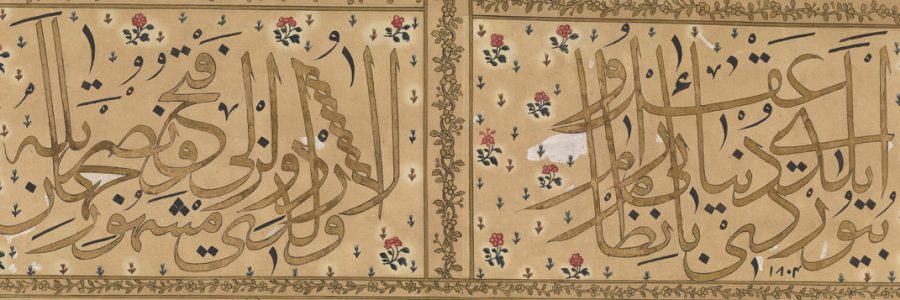
A delight in Turkish: E. J. W. Gibb and his library
Elias Gibb was a rather private and reclusive man of scholarship, but his contribution to Turkish studies in the form of translations and discussions of Turkish literary texts made him well-known in his field. He is also remembered in Cambridge for the acquisition, after his death, by the University Library, of part of his personal library known since then as the ‘Gibb Collection’.
Elias John Wilkinson Gibb was of Scottish decent, born in Glasgow in 1857 and from his early years he had an enthusiasm for languages. He studied at Glasgow University with which he had some family connections, focusing initially on maths and science. Subsequently he changed direction, specialising in European languages, and completed a translation of the medieval French fable Aucassin and Nicholete, published in Glasgow.
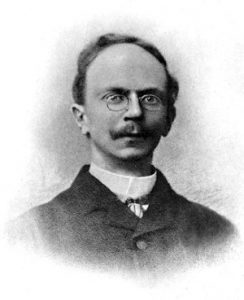
In his youth, Gibb had been entranced by stories from the ‘Thousand and One Nights’ and other eastern tales, and as a result, he decided to change the focus of his interests to Arabic studies. In 1886, he published some stories the from the ‘Nights’ as ‘The history of the forty vezirs: or, the story of the forty morns and eves’. His interests in Middle Eastern languages broadened further to include studies in Persian and Turkish and when only twenty-two years old he published his first English translation from a Turkish text, a sixteenth century historical narrative of the capture of Constantinople by the Turks, an extract from the ‘Taj-ut-tevarikh’ originally written by Hodja Sadeddin Efendi (1537-9), the Ottoman historian. The early part of Gibb’s career including his time in Glasgow has been documented by Glasgow University Library in a blog which can be read here.
Gibb gradually focused his interests more specifically onto Turkish literary studies and more precisely on poetry. In 1881, Gibb had joined the Royal Asiatic Society in London and made further useful contacts there and frequently entertained friends and colleagues in his home. He had the good fortune to be financially independent and so was able, all his life, to work as a private scholar. He travelled in Europe but never visited Turkey or other Middle Eastern countries.
Gibb’s very first publication on poetry was in his contribution to Stanley Lane Poole’s ‘The story of the nations: Turkey’, and it was on Turkish literature that Gibb continued to produce his most significant work, such as his ‘Ottoman poems’ published in 1882. He dedicated this volume to the British Ottoman scholar Sir James Redhouse, author of the ‘Turkish and English Lexicon’ (1890), the often-reprinted dictionary. Even at the end of the twentieth century this was still considered the most complete Ottoman dictionary ever published.Redhouse (1811-92), originally from a naval and military background, had worked as a government interpreter for the Ottomans in Constantinople and become fluent in Turkish. In the archives of Cambridge University Library there is a letter dated 1885, from Redhouse to Gibb, in which they discuss details of textual translation and the exchange of books (CUL MS Add.4251/1164). Also, in the archives there is a letter from the Embassy in Constantinople, signed by Charles Marling, a British diplomat, thanking Gibb for a copy of his ‘Ottoman poems’, possibly the specially made copy Gibb had sent there as a gift to Sultan Abdul Hamid II (MS Add.4251/939).
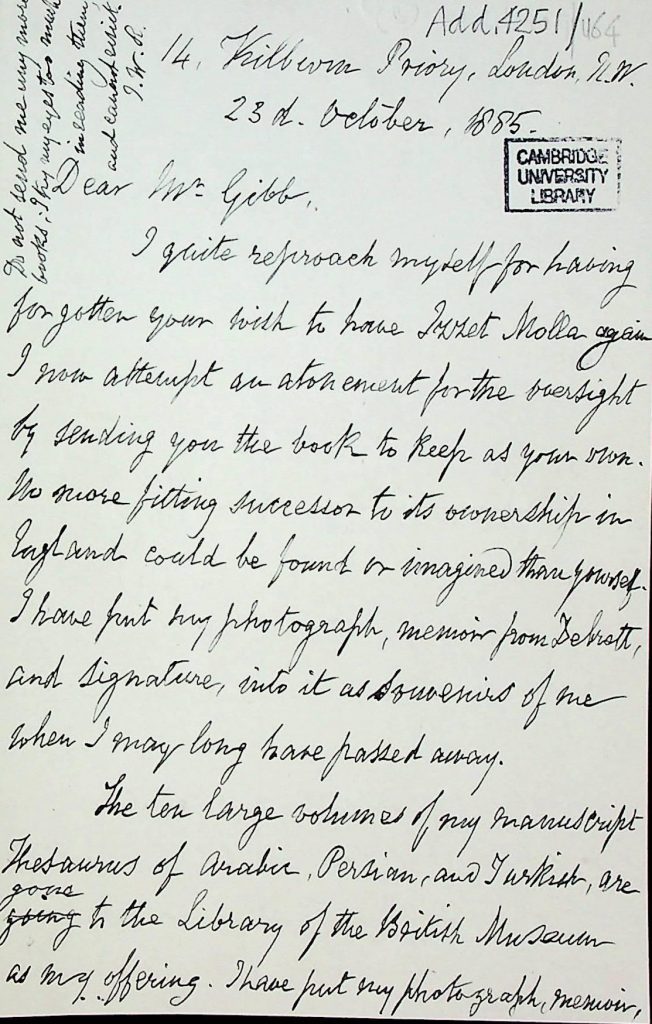
At some time during the 1880s, Gibb also met Edward Granville Browne, then a young scholar of Middle Eastern languages, whose enthusiasm had also begun with Turkish studies and who subsequently became Professor of Arabic at Cambridge (1902-26). Gibb formed a close friendship with Browne, they read Turkish texts together and there are letters with notes and marginalia on Turkish texts by Gibb in the archive of Browne’s papers in Cambridge University Library (CUL Browne Box 6).
In 1889, Gibb married and moved to London where he lived for the rest of his life and where developed his own personal library collection of printed books and manuscripts. In addition to his ability to read Turkish he was said to be able to speak it fluently enabling him to develop a circle of friends from among Turkish intellectuals and writers who were resident or visitors in London. He met Abdülhak Hâmid Tarhan (1852-1937), the Turkish poet and playwright, whose work he greatly admired. Gibb’s interest in Turkish literature and thought coincided with the era of political change in Turkey known as the Tanzimat and which had resulted in reforms both in the language and the introduction of new genres in literary writing. This occurred during the middle and later decades of the Ottoman Empire which was already in decline. Another of Gibb’s contacts was Ziya Pasha, (1825-1880), a writer, translator and administrator and one of the most important authors writing during the Tanzimat era. From 1865, Ziya Pasha was also a leading member of the reformist secret society known as the ‘Young Ottomans’ whose aim, in the late Tanzimat era, was to introduce more Western ideas into Turkish politics such as representative government. Gibb’s thinking was also much influenced by the writer Namık Kemal (1840-88), one of the foremost intellectuals and reformers involved in the formation of the ‘Young Ottomans’ group with whose criticism of classical Ottoman poetry Gibb found himself in agreement.
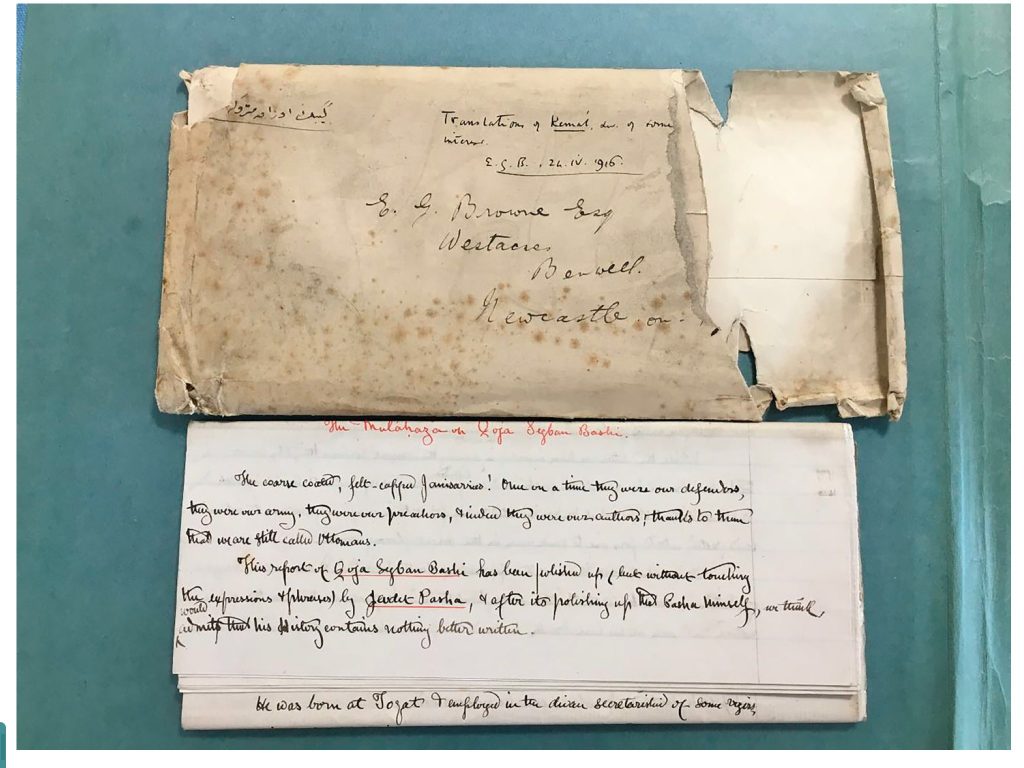
Gibb subsequently produced his most significant work ‘A history of Ottoman poetry’. Published in six volumes, this was a much more thorough consideration of the development of literary and historical context and remains a standard text on the history of Ottoman literature. But only the first volume of this work, which contains an introduction and a history of early Ottoman poetry, was published during his lifetime. Gibb died in 1901 at the early age of forty-four after contracting scarlet fever. The other volumes on Ottoman poetry on which Gibb was working at the time of his death were completed and published under the editorship of his friend and collaborator E. G. Browne. Volume five describes the new European school of Ottoman poetry dating from the mid 19th century Tanzimat era and with which Gibb had been so involved.
Gibb’s Library
During his years of scholarship Gibb had collected his own library of manuscripts and books. As Gibb was survived by his wife and his mother and they became responsible for the disposal of his estate. Gibb had already bequeathed the manuscripts to the British Museum, but the decision was made to divide his books into two parts; the printed books in English were donated to the British Embassy Library in Constantinople (perhaps reflecting Gibb’s connection with Redhouse) and those in Turkish, Arabic and Persian languages to Cambridge University Library (perhaps reflecting his friendship with Browne). A wide spectrum of works on Turkish literature is represented in the Gibb collection, but it is strong especially poetry and examples from the era of the ‘New School’ of poetry revolutionising earlier traditions and in which Gibb was especially interested. The collection of 400 volumes was catalogued by his good friend E.G. Browne in a volume published in 1906. In the introduction to this volume Browne describes more fully how this collection was developed by Gibb with the express intention of supporting his research into Turkish, especially poetry texts.
Although a Chair of Arabic had been founded in Cambridge as long ago as 1632, other Islamic languages from the region such as Persian and Turkish and more modern aspects of Middle Eastern cultures had never been taught there. This situation had been criticised for not producing candidates for diplomatic postings, but this attitude began to change during the last decade of the nineteenth century and the first decade of the twentieth. In 1884, the University had honoured Sir James Redhouse with an honorary degree in recognition of his diplomatic work in Turkey. E.G. Browne was himself instrumental in developing the study of Persian and Turkish in Cambridge and he notes, in his introduction to his catalogue of the Gibb collection, how it contains exactly the publications students would need to start their studies in Turkish. Gibb’s books, along with those of E.B. Cowell, the Sanskrit and Persian scholar and first Cambridge Professor of Sanskrit (1867-1903), form the core collections of printed books in these subjects and which supported the new growth of this teaching. The Gibb collection was housed in Old Library building situated in the Old Schools in central Cambridge, in a room with an ornate gothic window overlooking Clare College, known as the ‘Gibb Room’. The photograph below was taken in September 1933 just before the Library moved to its new building. In the Library’s modern West Road building erected in 1934, the books are housed in the Department of Rare Books where they are available to readers in the Rare Books Reading Room on request.
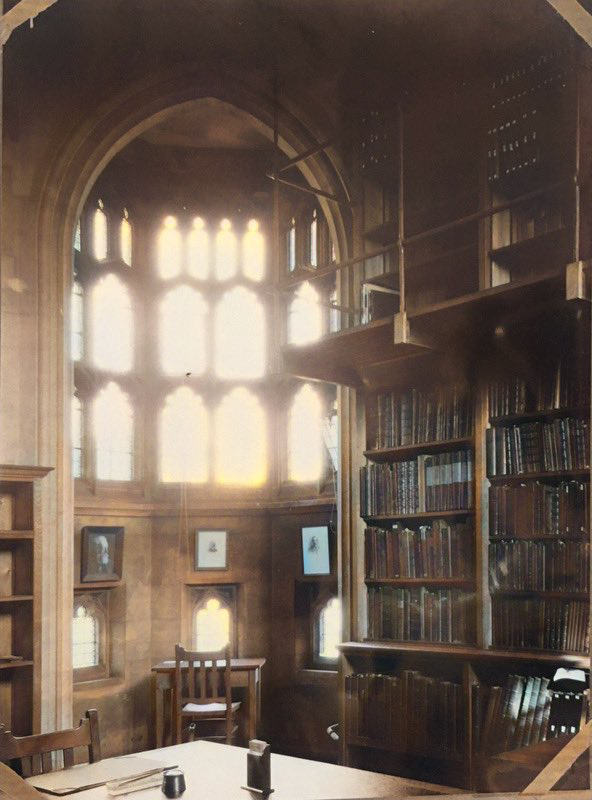
The Gibb Oriental Series
Gibb’s untimely death was also commemorated in other ways. In 1902, his mother was also responsible for the foundation of the Gibb Memorial Trust which sponsored the publication series which bears its name. This oriental literature series, of which the trustees also included Gibb’s widow, Browne, and other scholars including several Cambridge academics, aimed to publish works of history, literature, religion and philosophy in Arabic, Persian and Turkish. Many of these were translations into English, which could not easily find a publisher elsewhere. Special care was taken with font style and with the accuracy of transliteration, issues which had always complicated the production of printed texts in these languages and which the Gibb Memorial Series hoped to overcome. The archives of the Trust can be found in the Royal Asiatic Society in London. It is also thought that copies of the early volumes of the series were stored in Cambridge in the 1930’s in storage premises belonging to the University Press. Initially the Series published Gibb’s own works and those of his contemporaries, but it continues to this day publishing new volumes following in the footsteps of Gibb’s interests and scholarship.
Bibliography
Elizabeth H. Alexander, ‘E. J. W. Gibb’. Transactions of the Glasgow University Oriental Society, v. 6, 1934: 24–29.
Edward G. Browne, A hand-list arranged alphabetically under the titles, of the Turkish and other printed and lithographed books presented by Mrs. E.J.W. Gibb to the Cambridge University Library (Cambridge: University Press, 1906).
Edward G. Browne Papers, Box 6, Cambridge University Library.
Edward G. Browne, “Obituary Notices: Elias John Wilkinson Gibb.” The Journal of the Royal Asiatic Society, v. 34 (2), 1902: 480–489.
Nagihan Gür, The reading processes of a Scottish Ottomanist: E. J. W. Gibb and his young Ottoman sources. Middle Eastern Literatures, 21(2-3) 2018: 171-205, DOI: 10.1080/1475262X.2019.1576478
The Times: Obituary: 9th December 1901
Christine Woodhead. “Gibb, Elias John Wilkinson.” Oxford Dictionary of National Biography, Oxford University Press, 2004. http://www.oxforddnb.com/view/article/33382.
“Gibb Memorial Series” in Encyclopaedia Iranica Vol. X, Fasc. 6; 601-602 and online
